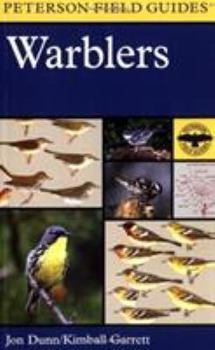A Peterson Field Guide to Warblers of North America
(Book #49 in the Peterson Field Guides Series)
Select Format
Select Condition 
Book Overview
Describes sixty species of North American warblers.
Format:Paperback
Language:English
ISBN:0395783216
ISBN13:9780395783214
Release Date:September 1997
Publisher:Mariner Books
Length:672 Pages
Weight:1.70 lbs.
Dimensions:1.7" x 4.6" x 7.3"
Customer Reviews
5 ratings
What a Guide Should Be
Published by Thriftbooks.com User , 19 years ago
Kimball Garrett and Jon Dunn worked together once again to produce a masterpiece. The information on status and distribution is remarkably accurate given the exceptional detail in which it is presented. The identification discussion is thorough and accurate. The discussion of subspecies, their taxonomy, and their identification (as is possible) is remarkable. The books only failing are the illustrations, which are flat and unrealistic for the most part. Their usefulness is limited.
Excellent supplemental reference
Published by Thriftbooks.com User , 21 years ago
This book provides good color plates of the warblers in various stages of plummage. The distribution maps are easy to read and color coded. I bought the book because of the multiple pages of natural history information on each species. The birding guide I use in the field has excellent illustrations but totally lacks in the supplemental information. So, when I get home, I grab this book to learn the biology of the species.
Second to None!
Published by Thriftbooks.com User , 23 years ago
Several years ago, while watching the bird feeders at Muskatatuck National Wildlife Refuge in Seymour, Indiana, I heard a voice behind me pointing out that there were two races of White-crowned Sparrow at the feeder. He went into detail about the subtle differences between the two. At first I thought to myself, who is this guy? Later, I realized that it was Jon Dunn! I have had a high respect for him ever since. Years later, he was the guest speaker at our bird club meeting. He presented some of the plates from his, at the time, upcoming new field guide to warblers. I fell in love with the plates from the very start. Thomas R. Shultz and Cindy House did a remarkable job, and the detail that was carefully gathered from museum specimens is second to none. I knew from the beginning that I had to have this new field guide and I couldn't wait until it appeared on the shelves. When I bought my copy of the finished product, it was even more than I expected. Aside from the detailed plates making fall and female warbler identification easier, the text is filled with information on virtually every aspect of life history of each species, with cross-references that will aid any serious researcher. More than just a field guide for identification purposes, this book belongs on the shelf of beginners and experts alike who share a passion for warblers.
An excellent resource for the serious birder...
Published by Thriftbooks.com User , 25 years ago
Dunn & Garrett have put together an exhaustive and educational treatment of warblers found in North America. It is guaranteed to be the standard text covering this family of birds. Its plates are beautiful and instructive, its text thorough and useful. Plates 31 and 32, which give show the undersides of the tails of all North American warblers, are worth the price of the book alone. If you are a serious birder or a backyard birdwatcher, you won't be disappointed to have this book around.
A treasure chest of information, but highly specialized
Published by Thriftbooks.com User , 26 years ago
I have been a bird-watcher (not a "birder," a term I find too trendy) since 1961, and have loved warblers perhaps more than any other group of avian friends. Spring each year means for me the delight of finding warblers--most of which are only transient visitors to the area where I have lived most of my life (the Middle Atlantic region). Thus, when I learned about this new Peterson's guide in Bird Watcher's Digest recently, I jumped at the chance to acquire it and improve my knowledge base. I had previously found the Peterson guides on "Hawks" and "Advanced Birding" especially helpful, and had used an old edition of Roger Tory Peterson's "Field Guide to the Birds" when I first learned about birds in the field. This field guide is quite unlike anything else in the Peterson series in appearance and content. It offers a great deal of specialized information, including very useful range maps (quite detailed), illustrations of each warbler species in a variety of plumages (not by RTP, but his successors are quite worthy), great photos interspersed in the text, and a vast amount of detail about habits, songs, range, current ecological status, and more than most people would ever want to know about subspecies. So the book does add a great deal to the knowledge base of even an experienced old timer like me. What I miss in this volume, however, is the spirit of (for want of a better word) "fun" or enjoyment of the subject. This volume lacks the poetry of A.C. Bent, Frank Chapman, or Hal Harrison, in their excellent books on warblers. All in all, though, few bird-watchers these days seem to be as interested in enjoyment of individual birds as they used to--perhaps a price paid for the increasing popularization of ornithology as a hobby--and even for some, a sport. This seems a volume written by and intended for people who are ornithologists in the scientific sense of the word. It would be extremely useful for bird-banders, who need to "age" and "sex" a bird in the field, for example. The rest of us can get something out of the new field guide, but I doubt that I would carry it along on a bird walk--the data are more than I need when I am in the field. It will continue to fascinate me as I leaf through it, however. And for anyone who enjoys warblers, this is a "must" to own.





